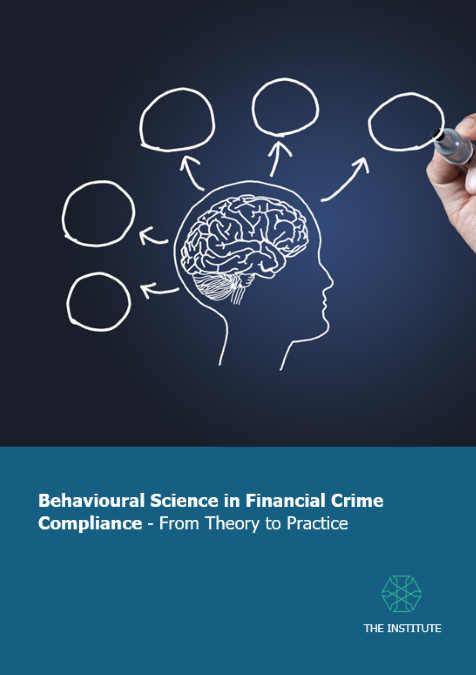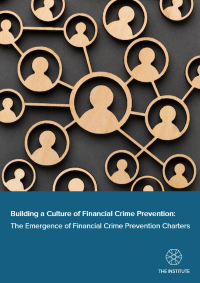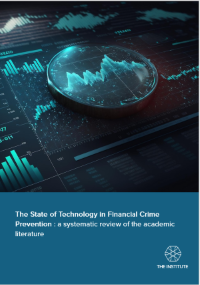
We regard the contributions of individuals with lived experience of financial crime prevention in the private sector as equally valid forms of knowledge alongside other, more traditional forms of knowledge generation. Our publications included:
- Systematic Reviews: Comprehensive summaries of the current research literature on topics related to financial crime prevention, learning and development, and professional practice.
- Practice-based thought leadership: Insights from experienced practitioners to support professional practice.
- Research-based thought leadership: Overviews of the available research on the topic and its implication for practice.
- Research Reports: Key findings and recommendations for practice, based on research undertaken by The Institute.
- Knowledge Exchange: Sharing academic ideas and insights with academic researchers, and bringing professional perspectives and experiences into academia.

The Role of the Money Laundering Reporting Officer
This report aims to comprehensively outline the role of Money Laundering Reporting Officer (MLRO) within financial institutions, detailing their responsibilities, liabilities, and the essential skills, knowledge, and competencies required to effectively discharge the role.
By synthesising legal and regulatory guidance, current academic literature, best practices and insights from practitioners, this study intends to shed light on the critical functions of MLROs in identifying, monitoring, and reporting suspicious activities, as well as their role in developing and overseeing the implementation of anti-money laundering (AML) policies and compliance programmes. The report will also address the challenges MLROs face, including maintaining up-to-date knowledge of evolving regulatory landscapes and technological advancements in financial crime prevention. Key questions the report aims to answer include:
- What are the key responsibilities and liabilities of MLROs?
- What skills, knowledge, and competencies are essential for MLROs to perform their roles effectively?
- How can MLROs shape a firm's culture to enhance the effectiveness of financial crime prevention strategies?
- Under what circumstances might an MLROs want to re-evaluate their position within a firm, and what steps should they consider if the environment is not conducive to effective AML compliance?
Download file below
Forthcoming Publications

Behavioural Science in Financial Crime Compliance - From Theory to Practice
This report aims to explore the application of behavioural science in financial crime compliance, providing practical guidance for Heads of Compliance, MLROs, and Heads of Financial Crime within financial institutions. It details how behavioural insights can enhance the effectiveness of compliance programmes, addressing both theoretical foundations and practical implementations. The report focuses on understanding how cognitive biases, decision-making processes, and social influences impact financial behaviour, and how these insights can be leveraged to design better compliance strategies and policies. Key questions the report aims to answer include:
- How can behavioural science principles be integrated into financial crime compliance to improve effectiveness?
- What specific cognitive biases and psychological factors are most relevant to financial crime prevention?
- How can training programmes be designed to account for behavioural tendencies in employees?
- What are the best practices for creating a culture of compliance using behavioural insights?
- How can financial institutions design incentive structures that promote ethical behaviour and deter financial misconduct?
- What practical tools and techniques can be employed to enhance the reporting and detection of suspicious activities?

Building a Culture of Financial Crime Prevention: The Emergence of Financial Crime Prevention Charters
In an era marked by the escalating complexity and sophistication of financial crimes, organisations across the globe face significant challenges in safeguarding their assets, reputation, and compliance with regulatory standards. The establishment of Financial Crime Prevention (“FCP”) Charters is emerging as a strategic instrument in strengthening organisational culture in the fight against financial crimes.
This report assessed the importance and potential impact of such charters, drawing upon academic research and good practices in corporate governance, organisational development, and organisational psychology. It finds that FCP Charters can serve as a formalisation of an organisation's commitment to preventing financial crimes by delineating clear roles, responsibilities, and authorities for the FCP function. While The Institute does not promote the development or implementation of FCP Charters, it has developed this report to aid firms in the design of such documents.

The Effectiveness of Regulatory Enforcement on the Prevention of Financial Crime
This report aims to critically examine the impact of regulatory enforcement mechanisms on preventing financial crimes, including money laundering, fraud, and embezzlement. Through a detailed analysis of academic literature, this study will evaluate the success of various regulatory frameworks and enforcement strategies across different jurisdictions. It will assess the role of international cooperation and the effectiveness of penalties in deterring financial crimes. The report will also explore the challenges faced by regulatory bodies in keeping pace with the rapid evolution of financial technologies and methods used by criminals. Key questions the report will address include:
- What regulatory strategies have proven most effective in preventing financial crimes, and why?
- How do differences in regulatory enforcement across jurisdictions impact the global fight against financial crime?
- What is the role of penalties and sanctions in deterring individuals and organisations from engaging in financial crimes?
- How effective are international agreements and cooperation in enhancing regulatory enforcement against financial crime?

The State of Technology in Financial Crime Prevention
This report seeks to explore the evolving landscape of technology in combating financial crime, with a particular focus on how innovations in digital forensics, artificial intelligence, and blockchain technology are revolutionising the fight against money laundering and fraud. By conducting a comprehensive review of existing academic literature, this study will illuminate the effectiveness of these technologies, identify gaps in current methodologies, and suggest areas for future research. Key questions the report aims to answer include:
- How have advancements in artificial intelligence and machine learning enhanced the detection and prevention of suspicious financial activities?
- What role does blockchain technology play in securing financial transactions and preventing fraud?
- To what extent have digital forensics evolved to track and analyse financial crime in the digital age?
- What are the challenges and limitations of current technology in detecting and preventing financial crime?

The Intersection of ESG and Financial Crime Prevention
This report examines the critical intersection between Environmental, Social, and Governance (ESG) initiatives and financial crime prevention, highlighting how robust financial crime prevention measures can significantly support and enhance ESG objectives. By reviewing current academic literature, this analysis will explore the ways in which preventing financial crimes such as fraud, money laundering, and corruption supports ESG practices. The study will also examine how ESG-focused companies may be less susceptible to financial crimes due to their transparent operations and strong governance structures. Key questions the report seeks to answer include:
- How do effective financial crime prevention strategies contribute to the achievement of ESG goals?
- In what ways can integrating ESG principles into financial crime prevention frameworks improve corporate transparency and accountability?
- How does the enforcement of financial crime regulations impact environmental protection and social welfare initiatives?
- What role does governance play in both preventing financial crime and promoting sustainable business practices?
- Can a focus on ESG principles help identify new methodologies for detecting and preventing financial crimes?


